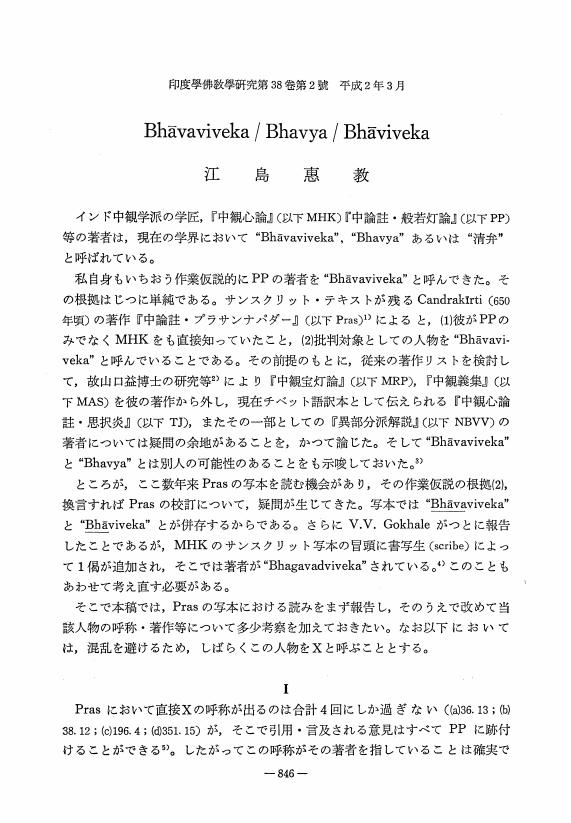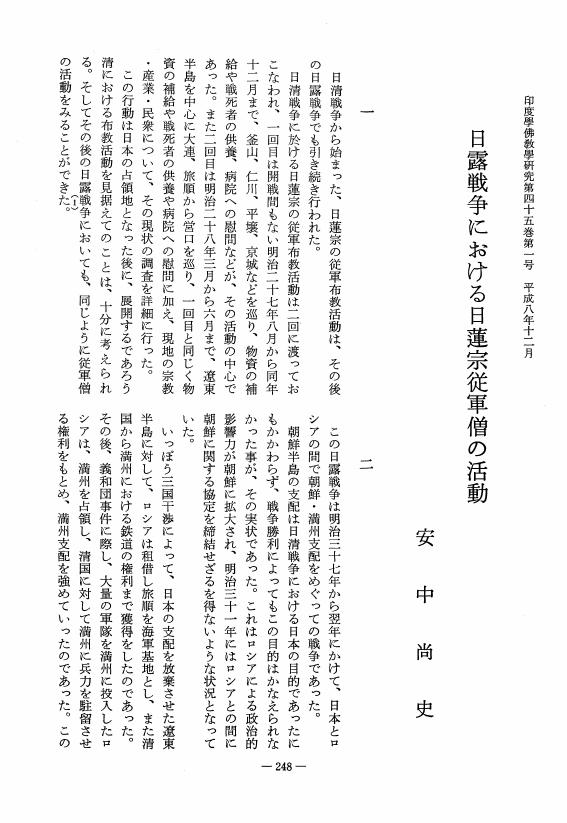2 0 0 0 OA 洞山五位説と異類中行の問題
- 著者
- 兪 炳根
- 出版者
- Japanese Association of Indian and Buddhist Studies
- 雑誌
- 印度學佛教學研究 (ISSN:00194344)
- 巻号頁・発行日
- vol.52, no.2, pp.651-653, 2004-03-20 (Released:2010-03-09)
2 0 0 0 『寳林傳本四十二章經』の課題
- 著者
- 横井 聖山
- 出版者
- 日本印度学仏教学会
- 雑誌
- 印度學佛教學研究 (ISSN:00194344)
- 巻号頁・発行日
- vol.3, no.2, pp.627-630, 1955
2 0 0 0 古代インドにおける授与の諸儀礼と水
- 著者
- 梶原 三恵子
- 出版者
- 日本印度学仏教学会
- 雑誌
- 印度學佛教學研究 (ISSN:00194344)
- 巻号頁・発行日
- vol.65, no.1, pp.242-235, 2016
<p>Since the Gṛhyasūtras, water has been involved in the rituals of giving gifts. As to the use of water at the giving of a girl to the suitor in the marriage ceremony, some Gṛhyasūtras preserve concrete prescriptions, while the Dharma texts prescribe it simply in the phrases "to give with water (<i>adbhir dā</i>)" or "to give being preceded by water (<i>udakapūrva</i>-)" without giving any details. Those simple phrases, which are attested since the younger Gṛhyasūtras and the Dharma texts, continue prevalently for other kinds of gift as well in post-Vedic texts.</p><p>In Buddhist texts, the giving of donations and the giving of a girl in marriage are described principally in the same or similar expressions in the narratives: one is said to give a gift with a water-jar in hand. On the other hand, the enumeration of forms of marriage and wife in the Vinayas preserves a peculiar and concrete use of water at a certain type of marriage. Such a unique description might reflect the various uses of water at the rites of giving gifts before their descriptions were unified and simplified.</p>
2 0 0 0 ヴェーダ文献における金属関連語
<p>Wilhelm Rau (1974) comprehensively discussed metals in Vedic literature. (Rau, <i>Metalle und Metallgeräte im vedischen Indien</i>, 1974) </p><p>In this paper, focusing especially on the base metals "<i>áyas-</i>," I investigate their usage in every stage of Vedic literature, referring widely to recent studies.</p><p>In the RV, <i>áyas-</i> is solely used as a general term for the base metals and there is no reference to its concrete name. In the stage of the Atharvaveda, <i>áyas-</i> is divided into two types, "black" (<i>śyāmá-</i>) and "red" (<i>lóhita-</i>), and other base metals like tin "<i>trapú-</i>" or lead "<i>sī́sa-</i>" become known. The situation in the YS<sup>m </sup>is almost the same, however, the word <i>lohá-</i>, the substantive for copper, is first used in a passage of the VS and TS. </p><p>A pair of passages in the black YS<sup>p</sup> (KS and MS) suggestively tells the property of pure copper; its high thermal conductivity. In the stage of ŚB, <i>áyas-</i> is no longer classified by color, and on the other hand, we can determine that it<i> </i>connotes specifically iron in some passages.</p>
2 0 0 0 撲揚智周伝についての二、三の問題 -師承関係を中心に-
- 著者
- 堀田 和義
- 出版者
- 日本印度学仏教学会
- 雑誌
- 印度學佛教學研究 (ISSN:00194344)
- 巻号頁・発行日
- vol.66, no.2, pp.933-929, 2018-03
2 0 0 0 OA 『六度集経』の成立について : 康僧会の動機と目的
- 著者
- 伊藤 千賀子
- 出版者
- 日本印度学仏教学会
- 雑誌
- 印度學佛教學研究 (ISSN:18840051)
- 巻号頁・発行日
- vol.61, no.2, pp.996-991, 2013-03-20
- 著者
- 小川 太龍
- 出版者
- 日本印度学仏教学会
- 雑誌
- 印度學佛教學研究 (ISSN:00194344)
- 巻号頁・発行日
- vol.66, no.1, pp.40-45, 2017-12
2 0 0 0 OA インド仏教研究へのイスラーム史料の可能性
- 著者
- 保坂 俊司
- 出版者
- Japanese Association of Indian and Buddhist Studies
- 雑誌
- 印度學佛教學研究 (ISSN:00194344)
- 巻号頁・発行日
- vol.41, no.1, pp.36-38, 1992-12-20 (Released:2010-03-09)
- 著者
- 師 茂樹
- 出版者
- 日本印度学仏教学会
- 雑誌
- 印度學佛教學研究 (ISSN:00194344)
- 巻号頁・発行日
- vol.66, no.1, pp.1-9, 2017-12
2 0 0 0 OA Bhvaviveka/Bhavya/Bhaviveka
- 著者
- 江島 惠教
- 出版者
- 日本印度学仏教学会
- 雑誌
- 印度學佛教學研究 (ISSN:00194344)
- 巻号頁・発行日
- vol.38, no.2, pp.846-838, 1990-03-20 (Released:2010-03-09)
2 0 0 0 フゥランテプテル研究序説
- 著者
- 稻葉 正就
- 出版者
- JAPANESE ASSOCIATION OF INDIAN AND BUDDHIST STUDIES
- 雑誌
- 印度學佛教學研究 (ISSN:00194344)
- 巻号頁・発行日
- vol.13, no.1, pp.1-10, 1965
2 0 0 0 OA 日露戦争における日蓮宗従軍僧の活動
- 著者
- 安中 尚史
- 出版者
- Japanese Association of Indian and Buddhist Studies
- 雑誌
- 印度學佛教學研究 (ISSN:00194344)
- 巻号頁・発行日
- vol.45, no.1, pp.248-252, 1996-12-20 (Released:2010-03-09)
- 被引用文献数
- 1
2 0 0 0 OA VasundharaとVasudhara
- 著者
- Sudan SHAKYA
- 出版者
- 日本印度学仏教学会
- 雑誌
- 印度學佛教學研究 (ISSN:00194344)
- 巻号頁・発行日
- vol.59, no.2, pp.995-990, 2011-03-20 (Released:2017-09-01)
2 0 0 0 学処解説の違いから見た有部系律蔵の系統分類
- 著者
- 佐々木 閑
- 出版者
- 日本印度学仏教学会
- 雑誌
- 印度學佛教學研究 (ISSN:00194344)
- 巻号頁・発行日
- vol.65, no.2, pp.809-802, 2017-03
2 0 0 0 学処解説の違いから見た有部系律蔵の系統分類
- 著者
- 佐々木 閑
- 出版者
- 日本印度学仏教学会
- 雑誌
- 印度學佛教學研究 (ISSN:00194344)
- 巻号頁・発行日
- vol.65, no.2, pp.809-802, 2017
<p>It seems to be strange that two different Vinayas, the <i>Shisong lü </i>十誦律, Ten Recitation Vihana, and the Mūlasarvāstivāda Vinaya, are extant but belong to the same sect, the Sarvāstivādins. The issue of how we should place them in the historical development of the Sarvāstivādins is particularly meaningful with respect to the investigation of the history of Buddhism, but no clear result has so far been found because of a lack of information; we have only some vague traditions.</p><p>In this article, the author presents information which clearly shows that the <i>Shisong lü</i> and the Mūlasarvāstivāda Vinaya were related with the Kāśmīra-vaibhāṣikas and Sautrāntikas respectively.</p><p>A passage in the Vinaya is quoted in a dispute between the Sautrāntikas and Kāśmīra-vaibhāṣikas described in the <i>Karmanirdeśa </i>of the <i>Abhidharmakośabhāṣya</i>. The corresponding passage can be found in both the <i>Shisong lü</i> and the Mūlasarvāstivāda Vinaya and, as a result of a detailed investigation, it turned out that the corresponding passage in the <i>Shisong lü</i> was modified for the purpose of reinforcement of the Kāśmīra-vaibhāṣikas' claim in the dispute appearing in the <i>Abhidharmakośabhāṣya</i>,<i> </i>and the corresponding passage in the Mūlasarvāstivāda Vinaya (Chinese version) was modified to reinforece the claim of the Sautrāntikas.</p><p>From this fact, we can establish a close relationship between the <i>Shisong lü</i> and Kāśmīra-vaibhāṣikas, and the Mūlasarvāstivāda Vinaya and the Sautrāntikas.</p>
2 0 0 0 OA 源信撰『阿弥陀経略記』の無量寿三諦説について
- 著者
- 小山 昌純
- 出版者
- JAPANESE ASSOCIATION OF INDIAN AND BUDDHIST STUDIES
- 雑誌
- 印度學佛教學研究 (ISSN:00194344)
- 巻号頁・発行日
- vol.51, no.1, pp.103-105, 2002-12-20 (Released:2010-03-09)
2 0 0 0 OA カマラシーラの因果論
- 著者
- 人見 牧生
- 出版者
- JAPANESE ASSOCIATION OF INDIAN AND BUDDHIST STUDIES
- 雑誌
- 印度學佛教學研究 (ISSN:00194344)
- 巻号頁・発行日
- vol.55, no.1, pp.441-438,1227, 2006-12-20 (Released:2010-07-01)
In the Karmaphalasambandhapariksa of the Tattvasamgrahapañjika, Kamalasila constructed his causal theory. In this paper, I focus on four points: Causal relations between two moments, Rules which governs causes, Mutual actions between cause and effect, Rules which governs effects. the outstanding characteristic of his causal theory is that he added two niyamas to limit the causal relations, i. e. one that limits causes and another that limits effects. The former is called “karanasaktiniyama,” which means limitation of the capacity of a cause to create an effect. The later is called “anantaryaniyama” which means that an effect originates immediately after a particular cause is in place. This is equal to the action, apeksa, which is the function of an effect on a cause. Thus, by adding these niyamas, Kamalasila understood causal relation in terms of “effect originates when particular cause exists” and “effect does not originate when particular cause exists” In this paper, I focus on these two niyamas, considering one aspect of his interpretation of pratitya-samutpada. In fact, his causal theory constructed in this chapter of TSP corresponds to the definition of pratitya-samutpada and dharmaniyamata in Kamalasila's Aryasalistambakatika. Thus, it can be pointed out that he interprets one aspect of pratitya-samutpada as “karyakaranabhava-pratiniyama.”
2 0 0 0 OA 道元禅師における皮肉骨髄について
- 著者
- 晴山 俊英
- 出版者
- JAPANESE ASSOCIATION OF INDIAN AND BUDDHIST STUDIES
- 雑誌
- 印度學佛教學研究 (ISSN:00194344)
- 巻号頁・発行日
- vol.46, no.1, pp.91-94, 1997-12-20 (Released:2010-03-09)
2 0 0 0 OA 明治維新期における廃仏棄釈の一断面-富山藩の場合-
- 著者
- 北沢 俊嶺
- 出版者
- JAPANESE ASSOCIATION OF INDIAN AND BUDDHIST STUDIES
- 雑誌
- 印度學佛教學研究 (ISSN:00194344)
- 巻号頁・発行日
- vol.19, no.2, pp.647-648, 1971-03-31 (Released:2010-03-09)








